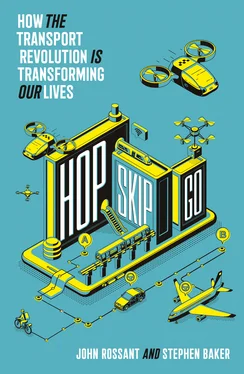With one caveat: it starts in cities. And that leads to the second big difference in mobility. While the Internet engendered its own virtual worlds on screens, mobility takes place in the physical realm we inhabit, much of it in our shared space. It involves roads and bike lanes, and machines that can hurtle down sidewalks and bang into us. It has to be managed. So from the get-go, there’s a clear role for government.
It stands to reason that the world’s cities would serve as laboratories for new forms of mobility. Only they can offer thousands of potential customers within a few blocks of one another. That’s why it’s a cinch to summon a ride-share or rent a bike in Munich or Tokyo, and why it’s impossible in most of Patagonia or Wyoming. Cities are also central to our story because, increasingly, humanity is turning into an urban species. Today, more than half of us live in cities. That number is expected to grow to 68 percent of the global population, topping 9.5 billion, by 2050. This means that the urban population is expanding at an average of 1 million people—or a city the size of Stockholm—every week. Facing this crush, many cities will find themselves looking to smart mobility as an antidote to urban paralysis and asphyxiation.
But still, people will have to figure out how to manage it. That’s why, in the course of telling this story, we take to the road (and the skies) to visit four cities on four continents. Each one is a petri dish for new ways of moving people and their things. Each will come up with its own formulas (while borrowing liberally from hundreds of other cities around the world). Their decisions, from taxes to investments in electric chargers, new train lines, and the rules of the road for autonomous fleets, will shape neighborhoods, define commutes, and establish competitiveness worldwide. After all, if a company has a choice between two cities, one gridlocked and smoggy, the other where movement is faster, cheaper, and greener, the decision is a no-brainer.
You might think that Los Angeles, the most iconic car city on the planet, would be the last place for a mobility revolution to occur. For starters, who can organize it? The mayor not only shares power with the city council, but he or she must also grapple with no less than eighty-seven other independent and headstrong municipalities within the vast LA County, with a population larger than forty-one individual American states. Yet as we’ll see, LA is positioning itself as a sprawling test bed for what’s coming. It has powerful assets: a sunny climate that smiles on scooters and bikes, an explosion of mobility tech start-ups, and also a leadership position in the aerospace industry. (A mastery of new materials and lightweight construction is highly relevant to the new contraptions we’ll be riding.) Perhaps most important, LA has a population that’s fed up with jammed freeways and ready for new approaches.
Later, we’ll visit Dubai, where a government flexed with power and a near-limitless budget is positioning itself as a mobility pioneer. The plan is to operate flying taxi drones by the early 2020s. By 2030, according to the government’s plans, one-quarter of the kilometers traveled in Dubai will be autonomous. And a planned vacuum train—a so-called Hyperloop—promises to shrink the two-hour drive to neighboring Abu Dhabi to a mere fourteen minutes.
Compared with LA and Dubai, Helsinki already seems like a mobility dream. It’s a walkable city with trams, subways, and buses that seem to pass by every minute or two. But it still wasn’t easy, a decade ago, for a college student named Sonja Heikkilä to cross town for soccer practice. Her frustrations grew into a vision: What if she could call up every available form of transportation on a single smartphone app—and then pay for mobility as a subscription, as with Spotify or Netflix? Her idea is taking root in Helsinki, where owning a car could one day become an anachronism, as quaint as buying a CD. (Auto executives need look no further than the beleaguered music industry to see how disruptive the transition from physical ownership to a digital service economy can be.)
Perhaps the most important stop on our global mobility tour is Shanghai. Until a few decades ago, it was a city of buses, bicycles, and swarms of pedestrians. Cars were rare. But now, like the rest of China’s industrial east, Shanghai is transformed. It’s become a thriving megapolis of twenty-five million, complete with jammed freeways and dirty air. The city’s soaring ambition is to solve these problems while leading the world in the race to new forms of mobility. Its greatest asset is a bottomless ocean of data describing the movements and moods of every person in the city. This data, combined with advanced AI in the hands of a powerful government and a single dominating Communist Party, could one day manage human movement with the precision of an industrial supply chain.
But is this the future we want, each of us being shuttled from place to place with remorseless efficiency, like the fenders, seat cushions, and spark plugs in a Toyota plant? With each advance of the mobility revolution, we’ll confront tough choices about the kind of world we’d like to live in. On one side will be the freedom of the individual. This includes the freedom to be wasteful, to travel incognito, even to get lost. Balanced against that are the interests of society, such as safety, efficiency, economic competitiveness, and a clean environment. This tension between the individual and society will run through the mobility revolution, and through this book. The contrast will come into stark relief as we explore the race to mobility in the world’s two leading economies, those of the United States and China.
In the end, the story is about us: billions of people on the move. We measure each trip we take, whether to Kuala Lumpur or the corner drugstore, in the distance we travel, the time it takes to get there, and the money it costs. Miles, minutes, dollars. Underlying each stage of mobility, from foot to horse to cars and jets, are the mathematics of these three fundamental variables: time, space, and money. The coming mobility revolution will be no different. In the conclusion, we’ll explore how the coming changes might revamp our conception of the geography of our planet, the hours in our days, and where in the world we might be able to go.
1 1: Hit Enter to Print Car 2: LA: Crawling to Topanga Canyon 3: 800 Electric Horses 4: Jurassic Detroit 5: Helsinki: Weaving Magic Carpet Apps 6: In the Company of Hawks and Nightcrawlers 7: Dubai: Grasping for the Cutting Edge 8: Idiot Savants at the Wheel 9: Shanghai: Petri Dish on the Huangpu 10: Squadrons of Pack Drones Conclusion: Minutes, Meters, and Moolah Acknowledgments Notes List of Searchable Terms Praise for Hop, Skip, Go About the Authors Also by Stephen Baker About the Publisher
Hit Enter to Print Car 1: Hit Enter to Print Car 2: LA: Crawling to Topanga Canyon 3: 800 Electric Horses 4: Jurassic Detroit 5: Helsinki: Weaving Magic Carpet Apps 6: In the Company of Hawks and Nightcrawlers 7: Dubai: Grasping for the Cutting Edge 8: Idiot Savants at the Wheel 9: Shanghai: Petri Dish on the Huangpu 10: Squadrons of Pack Drones Conclusion: Minutes, Meters, and Moolah Acknowledgments Notes List of Searchable Terms Praise for Hop, Skip, Go About the Authors Also by Stephen Baker About the Publisher
If you wanted to pinpoint the epicenter of movement in the United States, you might consider the otherwise unremarkable Los Angeles suburb of Torrance, California. It’s barely ten minutes south of Los Angeles International Airport, the fourth-busiest in the world. The ports of Los Angeles and Long Beach, which together handle more than one-third of the cargo coming into the United States, are just a couple of exits away. In the part of Torrance where Kevin Czinger has set up shop, near the junction of two teeming ten-lane interstates, the 110 and 405, the wide boulevards seem endless. They’re flanked by warehouses and dominated by trucks. The skinny palm trees in the medians look lonely and forlorn.
Читать дальше












